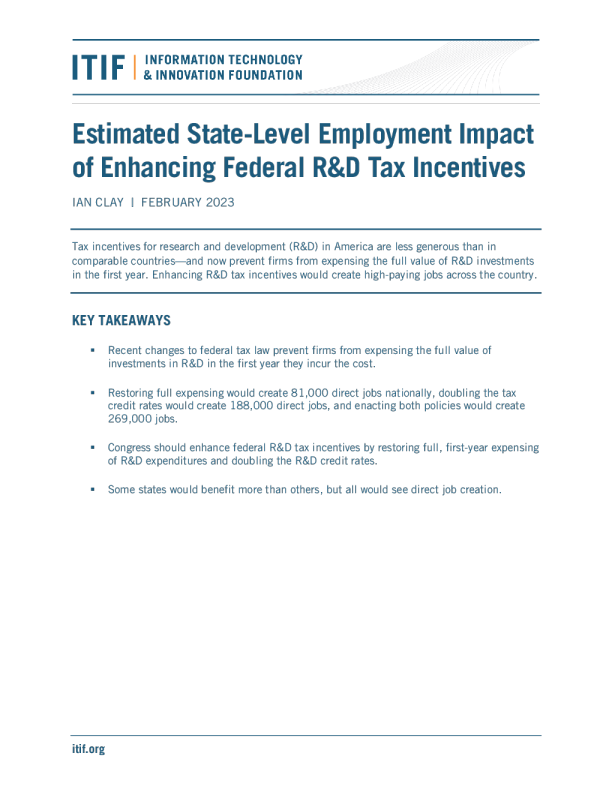Estimated State-Level Employment Impact of Enhancing Federal R&D Tax Incentives
 AI智能总结
AI智能总结
EstimatedState-LevelEmploymentImpactofEnhancingFederalR&DTaxIncentives IANCLAY|FEBRUARY2023 Taxincentivesforresearchanddevelopment(R&D)inAmericaarelessgenerousthanincomparablecountries—andnowpreventfirmsfromexpensingthefullvalueofR&Dinvestmentsinthefirstyear.EnhancingR&Dtaxincentiveswouldcreatehigh-payingjobsacrossthecountry. KEYTAKEAWAYS RecentchangestofederaltaxlawpreventfirmsfromexpensingthefullvalueofinvestmentsinR&Dinthefirstyeartheyincurthecost. Restoringfullexpensingwouldcreate81,000directjobsnationally,doublingthetaxcreditrateswouldcreate188,000directjobs,andenactingbothpolicieswouldcreate269,000jobs. CongressshouldenhancefederalR&Dtaxincentivesbyrestoringfull,first-yearexpensingofR&DexpendituresanddoublingtheR&Dcreditrates. Somestateswouldbenefitmorethanothers,butallwouldseedirectjobcreation. CONTENTS KeyTakeaways1 Introduction3 PoliciesUnderConsideration3 FullFirst-YearExpensing3 RegularandAlternativeSimplifiedCredits3 R&DGainsFromRestoringFullexpensing4 ChangestotheB-IndexSubsidyRate4 EconometricModel5 Results5 R&DGainsFromDoublingCreditRates6 EstimatingForgoneTaxRevenue6 EstimatingtheIncreaseinBusinessR&D6 State-LevelEmploymentEffects7 Conclusion8 Appendix13 CalculatingtheChangeintheB-IndexSubsidyRate13 EconometricModelandResults13 Estimating2022State-LevelR&DData15 Endnotes19 INTRODUCTION BusinessR&Ddrivesinnovationandcompetitivenessandcreatesmillionsofhigh-payingjobs.FederalR&DtaxincentivesexisttospurfurtherbusinessinvestmentinR&DandraiseR&Dexpenditurestowardtheirsociallyoptimalrate.However,R&Dinvestmentisstillwellbelowthatoptimallevel,andU.S.businessR&Dtaxincentivesarepaltrycomparedwiththoseinotheradvancedeconomies.Therecentremovaloffirst-yearfullexpensingofR&Dexpenditureshasonlyworsenedtheseproblems.IncreasingthegenerosityofR&DtaxincentiveswouldboostbusinessR&Dspendingandcreatejobsinall50statesplusWashington,D.C. Thepurposeofthisreportistoestimatetheemploymentgainstoeachstate(andWashington,D.C.)underthreescenarios: 1.IffullexpensingofR&Dexpendituresinthefirstyearisrestored. 2.Ifthestatutoryratesoftheregularcredit(RC)andalternativesimplifiedcredit(ASC)forqualifiedresearchanddevelopmentexpenditures(QRE)aredoubledto28percentand40percent,respectively. 3.Iffullexpensingisrestoredandtheratesaredoubled. Thisreportbuildsona2020InformationTechnologyandInnovationFoundation(ITIF)reportbyJohnLesterandJacekWarda.1Toavoidovercomplicatingthisnewreport,weonlyconsiderhypotheticalchangestofederaltaxincentivesanddonotconsiderstate-specificpolicies. Moreover,wereportonlydirectjobcreationanddonotestimatethenumberofindirectandinducedjobs.States’actualemploymentgainsarethereforeunderstated. Overall,weestimatethat81,000directjobswouldbecreatediffullexpensingwererestored,188,000wouldbecreatedifthecreditratesweredoubled,and269,000wouldbecreatedifbothactionsweretaken.Thesejobsareespeciallydesirablebecausetheypayhighwages—themediannationalhourlywageintheScientificResearchandDevelopmentServicesindustry(NAICS541700)was$48.47asofMay2021—andhavehighemploymentmultipliers.2ThestatesexpectedtobenefitthemostarethosewithhighbusinessR&Dintensities—definedasbusinessR&Dexpendituresasashareofgrossdomesticproduct(GDP)—includingCalifornia,Massachusetts,Michigan,andWashington.Butallstatesareexpectedtoseejobcreation. POLICIESUNDERCONSIDERATION FullFirst-YearExpensing Aspartofthe2017TaxCutandJobsAct,startingin2022,U.S.businessesarenolongerallowedtofullydeducttheirR&Dexpendituresfromtheirtaxableincome—apracticeknownas“first-yearfullexpensing.”Instead,theymustdeducttheexpensesaccordingtoa5-yeardepreciationschedule(anda15-yearscheduleforR&Dperformedabroad).Becauseofthetimevalueofmoneyanddevaluationfrominflation,thepresentrealvalueofthedeductions(intheyeartheexpensesaremade)islower;thus,theincentivetoinvestinR&Dislower. RegularandAlternativeSimplifiedCredits TheUnitedStatesprovidestwoprimaryfederalR&Dtaxcredits:theRCandtheASC.ThesecreditsprovideanincentivetoinvestinR&Dbyultimatelyloweringtheacquisitioncoststhefirmsbearbyreducingtheirfederalcorporateincometaxliability. UndertheRC,firmscanclaima20percentcreditonQREabovea“baselevel,”whichisequaltotheirR&Dintensityintheperiod1984–1988timestheaverageofsalesintheprecedingfouryears.QREincludesworkers’wages,thecostofcertainsupplies,andtherentalorleasecostsofcomputersandcomputingservices—andtheyaccountforalmosttwo-thirdsoftotalbusinessR&Dexpenditures.3Therearespecialrulesforcalculatingbase-periodR&Dintensityifafirmdidnotexistovertheentire1984–1988period.4Ifafirm’scurrentR&Dspendingexceedsthebaselevel,itcanclaima20percenttaxcreditonthedifference.However,thebaselevelmustbeatleasthalfofcurrent-yearR&Dexpenditures.Forfirmssubjecttothisconstraint,eachadditionaldollarspentonR&Draisestheminimumbaselevelby50cents,soonlyhalftheadditionaldollariseligibleforthe20percentcredit.Thesefirmsthereforefaceaneffectivemarginalcreditrateequaltohalfthestatutoryrate,or10percent. Alternatively,theR&DASCletsafirmclaima14percentcreditonQREabove50percentofitsbaselevel,whichisthefirm’saverageQREovertheprecedingthreeyear
你可能感兴趣

Gender, Selection into Employment, and the Wage Impact of Immigration

Pitfalls of Tax Incentives For Long-Term Care: Commentary

The Impact of Immigration on the Employment Dynamics of European Regions

